2 Getting Started
This chapter provides an introduction to accessing and using the Supplier Evaluation Workspace. The following topics are covered:
Login
Your Supplier Evaluation Identity Provider profile provides access to the Workspace. When you log in, you are taken to the Workspace.
Terms and Conditions
If you are new user, you must accept the portal owner’s Terms and Conditions, if required by the portal owner. The initial user for a new supplier must also complete the Registration process. The system will guide you through these tasks:
-
The Workspace page is loaded with an overlay message stating whether you must accept the terms and conditions and/or complete the supplier Registration process before proceeding:
Figure 2-1 Login Overlay
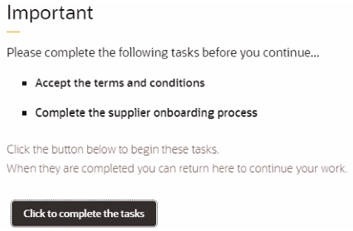
-
If you are required to accept the terms and conditions, clicking the button will present the Terms and Conditions page, with options to accept or reject. If you reject, you are returned to the Login page, and cannot access the application.
-
If you are required to complete the supplier onboarding process, clicking the button will present the Registration wizard for you to complete.
-
Once all Terms and Conditions and Registration requirements are complete, the Workspace page opens.
Workspace
The Workspace page is the hub of your access to all areas of the application. From here you have access to the new Assignments, Announcements, and KPIs features, plus the Supplier Evaluation modules and submodules.
Figure 2-2 Workspace Page

Clicking the Legal Notices link at the bottom of the page displays a message box containing options to display details of all third-party software components that are used within the system.
Figure 2-3 Legal Notices

To view the legal notices, click the link. A page appears containing links to the Oracle Retail Licensing Information documents, which describe the third-party software components. An example is shown in Figure 2-4.
Figure 2-4 Legal Notices Example
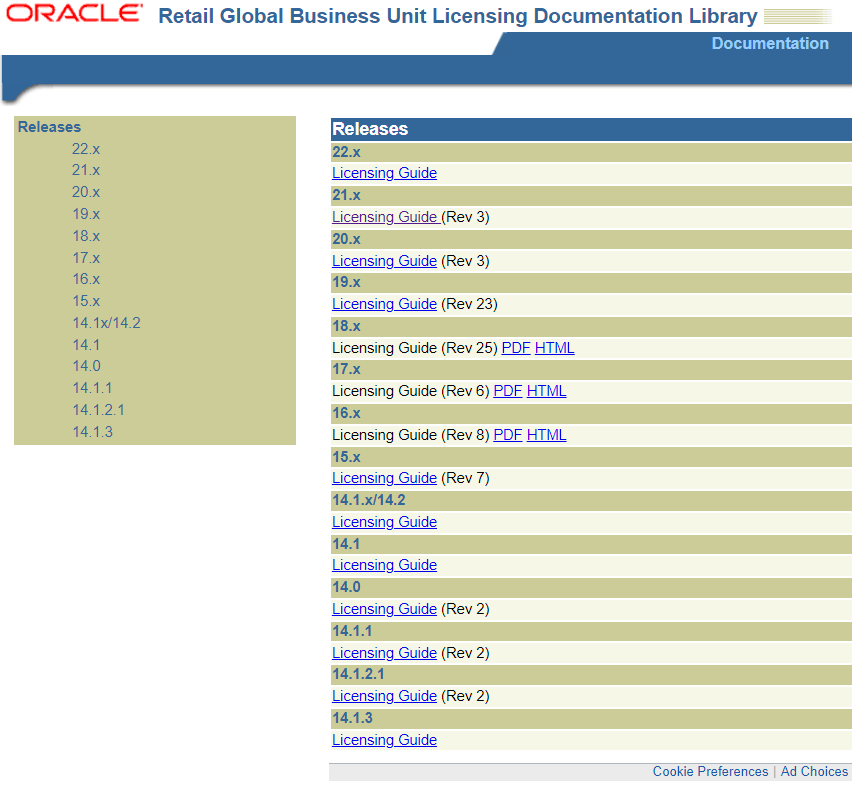
Navigation
The following options are available for navigating within Workspace and beyond, subject to your assigned access rights/permissions:
|
The Menu icon expands and collapses the left-hand menu area to show the options in a static pane rather than overlaying the main Workspace page. The menu area contains icons to open the Application, Tasks, Administration, Favorites, and Recent Items menus. |
|
|
The Applications icon provides links to the Oracle Retail applications you have licensed. Initially, it will just contain Supplier Evaluation. |
|
|
The Tasks icon presents the Workspace and Supplier Evaluation options to which you have access. |
The Workspace option includes links to the Workspace page, your Assignments, Announcements, and KPIs. The other options correlate to the module and submodule options you have available to you; these options take you directly to the relevant page in Supplier Evaluation.
The search box allows you to locate specific tasks using a type-ahead filter. Clicking an option that has sub-options, as identified with a right chevron (>), presents the list of sub-options. Use the left chevron (<) to return to the main option.
Figure 2-5 Tasks Menu
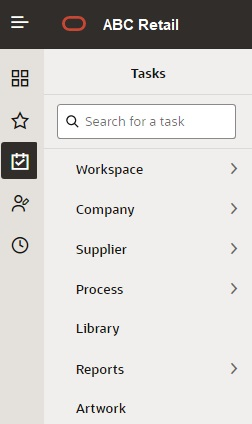
|
The Administration icon presents any Workspace administration options to which you have access. The options are presented per the Tasks menu. If there are no options available to you, the icon is hidden. |
|
|
The Favorites icon presents a list of any bookmarks you have made within the application. The items are listed in the order you bookmarked them, with the most recent at the bottom. The type of record and its description is shown. If the description is truncated, hovering over will show the full text. |
Figure 2-6 Favorites Menu

|
The Recent Items icon presents a list of pages you have recently opened within the application. The items are listed in the order you opened them, with the most recent at the top. The date of when the record was opened is shown, along with the type of record and its description. The box will expand to fit the full description. The Preferences option in the User menu allows you to set the number of items to show. |
Figure 2-7 Recent Items Menu
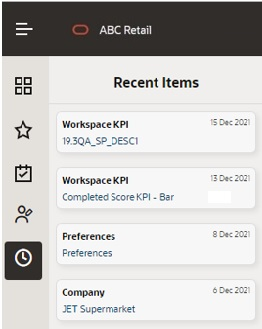
|
The Application Help menu contains two options:
|
|
|
The User menu contains four options:
|
|
|
The Actions menu contains actions that are relevant to the current page. The Workspace page and list views will include the option to Refresh the contents. Form pages will include options to Edit the page and so forth. |
|
|
The Refresh icon appears on the Workspace page (including the Favorites and Recent Items contents), and on list view pages. It refreshes the contents of the page, showing the time when the page was last refreshed. |
Other elements of the Workspace page include:
-
The Header bar shows the name of the application and the Menu icon.
-
The Tabs bar shows which pages you have open. A maximum of 15 pages may be open concurrently.
-
The Title bar sub-heading shows the page name and the Actions and Refresh option when they are available.
-
The main Body of the Workspace page contains your Assignments, Announcements, and KPIs.
Assignments
The Urgent Assignments banner appears at the top of the page if you have any urgent assignments. The banner will always show if you have urgent items; it cannot be hidden.
Figure 2-8 Urgent Assignments in Workspace

The Assignments Due pane shows all your assignments.
Figure 2-9 Assignments Due in Workspace
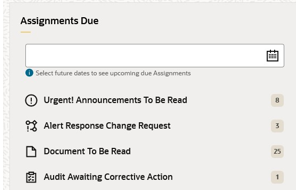
For further details, see the Assignments chapter.
Announcements
Announcements provide the ability to categorize them as Resources. Both appear within the Workspace page, grouped separately.
Figure 2-10 Announcements in Workspace
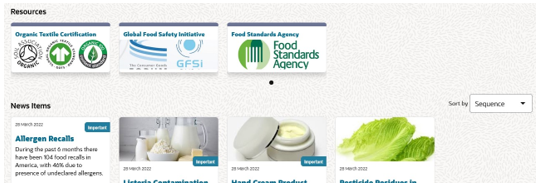
Announcements have features including the categorization, targeting, and readership logging facilities. Resources are intended for more static announcements, such as links to external bodies or training resources.
For further details, see the Announcements chapter.
KPIs
The KPIs dashboard allows you to configure a set of KPI (Key Performance Indicator) report outputs to show as tiles within your Workspace page.
The tiles show a thumbnail representation of the KPI data; opening the tile shows the full size chart or table.
Figure 2-11 KPIs in Workspace

For further details, see the KPIs chapter.
Administration
The Administration icon in Workspace contains any administration options to which you have access.
Announcements
If you have News Administrator access rights, you will have access to the following:
-
The Photo Album option will appear in the Administration menu. It provides access to the repository of images used in Announcements.
-
The Announcement Category and Announcement Flash Messagesglossaries, used in Announcements, are maintained in the Admin area.
For further details, see the Announcements chapter.
Security
The Permissions rules include the following, to cater for Workspace specific access rights.
| Area | Access Rights |
|---|---|
|
Workspace page |
Accessible by all users. |
|
Tasks and Administration options |
The options shown are limited to those that the user has access to, based on the configured Permissions rules. |
|
Urgent Assignments banner |
All users who have urgent Assignments. |
|
Assignments Due pane |
All users, filtered to show their Assignments. |
|
Resources and News Items |
All users. |
|
Announcements maintenance |
Users with the News Administrator authority profile only. |
|
Review Readership action |
Users with the News Administrator authority profile only. |
|
Photo Album |
Users with the News Administrator authority profile only. |
|
KPIs Dashboard |
Retailer/portal owner users with the Advanced Reporting Administrator, Advanced Reporting User, or Advanced Reporting Reader authority profiles. |
|
Manage Workspace KPIs |
Only accessible to retailer/portal owner users, and who have Advanced Reporting Administrator or Advanced Reporting User authority profiles; otherwise, it is hidden. |
All rich text data entered in Workspace is cleansed to ensure there are no illegal HTML characters, such as for an SQL injection attack.
Internationalization
Some of the initial features are as follows:
-
Language translations are provided for the JET UI components, such as menu options and buttons, for the languages supported by JET.
-
Language translations are provided for the application UI components, such as field labels and error messages, using the System Text facility.
-
Language translations can be entered for certain data fields within the Announcements record. For further details, see the Announcements chapter.
-
Workspace determines the user's language from their User record, regardless of their Identity Provider profile, and the user’s time zone from the locale of the device they are using.
Server Repave Notification
The application runs as part of a distributed cloud computing infrastructure. This infrastructure allows for automated switch-over in the event of failure, and for repaving switch-over for regular hardware rotation and patching. Periodically (typically every 14 days), the application will therefore repave to run on a different server instance. When this occurs, any open sessions are transferred to another running pod. The time taken to transfer these sessions is dependent upon the number of active users on the pod at that particular instance. In case of high usability, it is possible that a timeout on the browser could be experienced.
In order to handle the repaving in a way that the user gets the opportunity to reconnect to the new server instance prior to the point of switch-over, a notification is issued that the server has a limited lifetime remaining, so the user must save any changes and log out then log on again, otherwise risk being disconnected and losing any unsaved changes. When the user logs back on, the session will automatically connect to the new server instance and clear the notification.
When the system detects that repaving is imminent, the notification is shown as pop-out toast message.